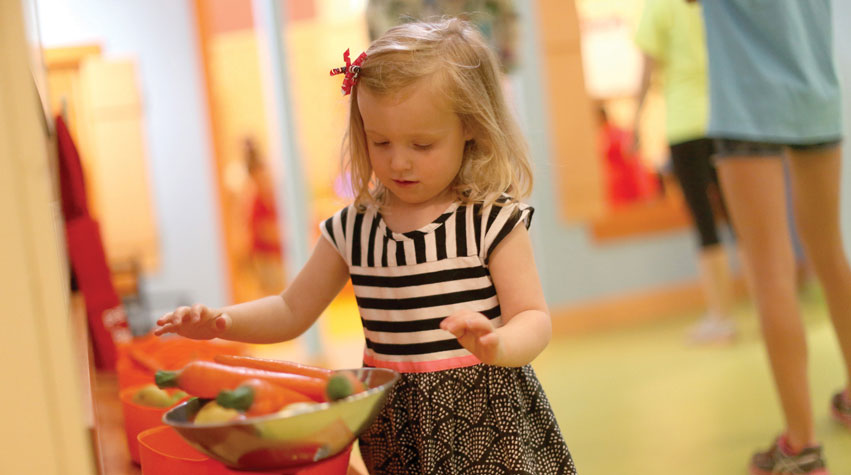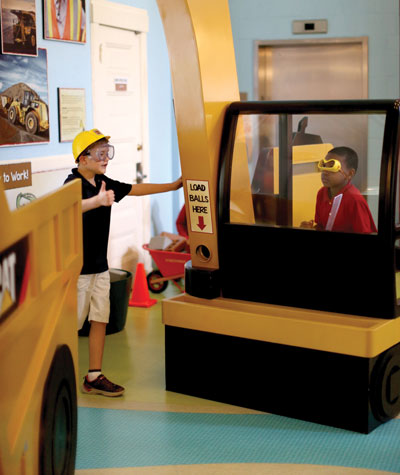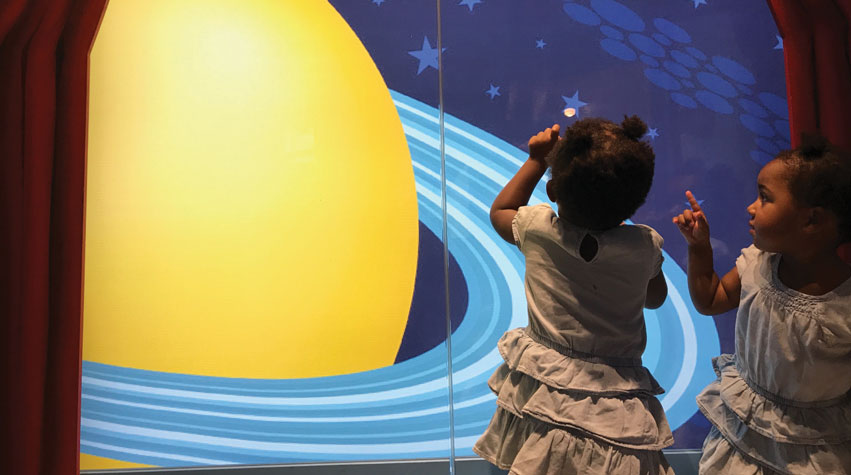
A child is playing with a wheelbarrow filled with foam bricks of different shapes and colors. One by one he takes out a brick, walks a few feet away, and adds it to a stack. He adds red bricks to one stack, white bricks to another. He looks up and grins, before knocking over both stacks and running away.
A young girl is playing at a water table, holding a sieve. She scoops water, which drains through the sieve, and does this over and over. Then she finds a different scoop: a cup without holes. She scoops with this, looking back and forth between the sieve and the scoop.
Two children are playing in a toy kitchen. One child is looking for pieces to make a “hamburger” for his mother. He finds two plastic pancakes and a plastic piece of meat. He looks up at the girl still looking through the pile. He finds a plastic cookie and hands it to her. She takes it and pretends to eat it.
At the Peoria PlayHouse Children’s Museum, we often see situations like those described above. We spend a great deal of time thinking about the benefits of play, from learning new skills to developing curiosity and social aptitudes. By watching our young visitors and reading widely about play, we can recognize the deep learning happening when they manipulate objects, imagine new worlds and engage with each other.
If you google “define education,” you will find two definitions: (1) “the process of receiving or giving systematic instruction”; and (2) “an enlightening experience.” When we think about education, we often are thinking about the first definition: a school or other organization that creates the conditions that help people gain knowledge or skills. Schools create these conditions, training teachers and crafting a curriculum, in order to impart specific knowledge and skills to their students.
But for young children, a great deal of education fits the second meaning: self-motivated experiences that lead to a deeper understanding of the world. While sitting in a high chair in the kitchen, one might discover that when you hit the tray with a spoon it makes a sound, or when you let go of food it falls to the floor. The child is learning about cause and effect, and his or her role in this process. Later, a child might go into the backyard and come back with new ideas about how to work in a team, invent a game or roll a ball; he or she might have found where squirrels hide their food or learned that different trees have differently shaped leaves.
We often call these activities and experiences play, and we know it is a critical part of how children learn. What exactly is play, and what can we say about what and how children learn? Why is this learning important? Finally, how can institutions like the PlayHouse, as well as parents and caregivers, support these endeavors?
 What is play, and what does it have to do with learning?
What is play, and what does it have to do with learning?
Play means engaging in an activity for the enjoyment of the activity itself—not for tangible rewards or because we have been told to do it. In his article “The Elements of Play,” Scott Eberle defines play as “apparently purposeless, voluntary, outside the ordinary, fun, and focused by rules.” Most importantly, play is something undertaken for its own sake, not to accomplish a larger goal. So banging out a tune on a piano and singing along is play, but playing an instrument in the symphony is considered work. Digging a hole in the ground to see what is there is play; digging a hole in the ground as part of a road repair project is work.
In “The Power of Play: A Research Summary on Play and Learning,” Dr. Rachel White identifies five types of play. These types of play overlap, but are useful categories in identifying what a child is doing and learning while they play. Social play involves interaction between two or more people. Peek-a-boo is social play. When one child pretends to make a meal in order to serve it to another child, this is social play.
- Social play teaches children how to understand other people, how to get along and even how to empathize with others.
- Object play refers to engagement with physical things in the world: building a block tower, using a spoon to drum on a pot, pretending a cookie is an airplane. Through object play, children experiment and practice scientific reasoning. They identify and solve problems, learning how to think flexibly and innovatively. They practice basic math skills, such as sorting and classifying.
- Pretend play involves imagining a different reality. It includes imagining a friend is your baby and rocking him to sleep, or holding up a square block to your ear and pretending to talk on the phone. Pretend play fosters creativity. It supports children in building language and the ability to tell stories, and thus to communicate more generally. It helps children learn self-control and coping skills, and to navigate social interactions.
- Physical play is large-motor activity such as running, skipping, jumping and climbing. It includes playing dodgeball at recess or rolling down a grassy slope. Through physical play, children develop motor skills and build strength and endurance. Physical play involves movement and contributes to health the same way exercise does. Like pretend play, physical play helps children learn self-control.
- Media play is using technology to play, usually through video games. This type of play is controversial, partly because some video games contain disturbing imagery, and because playing can become addictive and antisocial. That said, according to White, most research indicates that “video game players are reported to be more likely to participate in sports, less likely to be obese, more interested in civic involvement, more obedient of parents, more likely to have academically-minded friends, less likely to have risk-seeking friends, and no more violent than non-video game players.” Video games can also teach decision-making and problem-solving.

Why is learning through play important?
Too often play is seen as frivolous and pushed aside in favor of explicit math and literacy instruction. Instead of free play, young children might be asked to listen to a book and answer questions, trace the letters of the alphabet, count objects or do basic addition. In a recent study conducted by New America, a Washington DC think tank, researchers found that the majority of elementary school principals “felt pressured to limit play time in pre-K, kindergarten and the early grades to focus on academics. In essence, they did not always make a direct connection between play and learning.” This perspective is unfortunate, as there are a number of reasons why play is essential to early learning.
First, children naturally learn through play. When given the opportunity, children will instinctively explore and experiment. Psychologist Alison Gopnick, when asked how parents can “maximize their baby’s unique mental abilities,” suggested they should “have lots of stuff around for them to play with and let them play without worrying too much about whether they're getting academic skills or they're making a mess.” Gopnick, author of The Scientist in the Crib, argues in a TED talk that children are designed to learn, and that they naturally spend their time hypothesizing and testing their hypotheses.
Second, the types of learning that happen through play—the exploration and experimentation that children are naturally drawn to—are in line with what we call “21st-century skills,” including creativity, problem solving and collaboration. As we have seen, social play teaches the tolerance and sensitivity needed for collaboration; object play teaches flexible and innovative thinking; pretend play fosters creativity. Schools are still figuring out how to teach these skills in an academic context that was designed in the 18th century to impart information and basic skills such as reading and math. While we want children to learn these skills, it is essential they learn more—that they develop the creativity and communication abilities that will allow them to excel in an uncertain future requiring skills and knowledge we can’t yet predict. Play cultivates these 21st-century skills.
Finally, play is, by definition, fun. The more children learn through play, the more they learn to love learning. A love of learning is motivation to become a lifelong learner, which we want for all of our children.
 How can adults help?
How can adults help?
All parents and communities want their children to succeed. We live in a world in which children are overscheduled and challenged to learn academic skills from a young age. Often we feel children are unsafe left alone outside. In this environment, what can adults do to help children learn through play?
- Allow children ample time to play. Children need time to engage in the types of play outlined above. Studies show that “children often need at least half an hour to plan, set up and execute play,” White writes, and that children are more likely to engage in constructive or dramatic play when given 30 minutes than when limited to 15 minutes. Support play by ensuring that children have ample periods of unscheduled time.
- Let your child take the lead. Let children choose what to play. When a child has trouble engaging in play, adults often become “play leaders,” actively guiding their play. This is a great way to get children started when they have trouble initiating play, but once they are comfortable, step back and let them go!
- Make sure at least some play time is with toys or in spaces that encourage creativity and divergent thinking. When selecting games for your home, make sure that some of them allow children to think creatively. Encourage children to invent their own rules, or transform games into something new: for example, using game pieces as characters in dramatic play, or transforming a jump rope into a landscape.
- Bring your child to spaces where social play can happen. Offer your child time in a space with other children. While playing in backyard with siblings is wonderful, it is also important to offer children an environment in which they can negotiate complex relationships, engage in social play with strangers, and be inspired by children with new ideas.
The mission of the Peoria PlayHouse Children’s Museum is to provide children with the tools and inspiration they need to be explorers and creators of the world. We believe that play is a powerful tool toward this end, empowering children to learn about and reinvent the world, while becoming lifelong learners, creators and citizens. iBi

